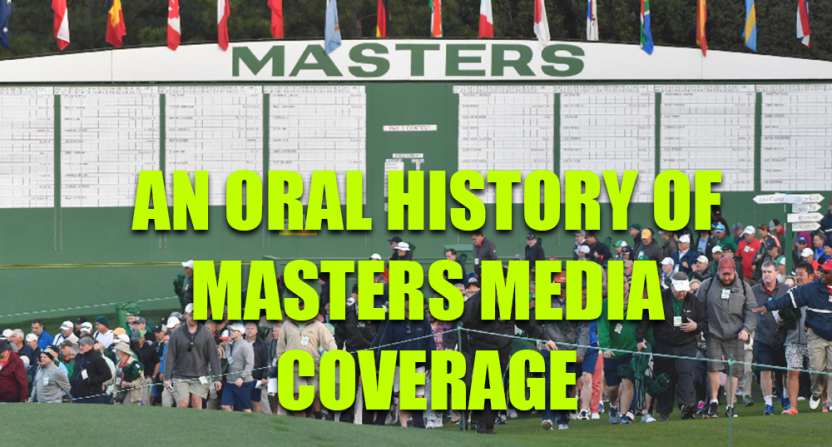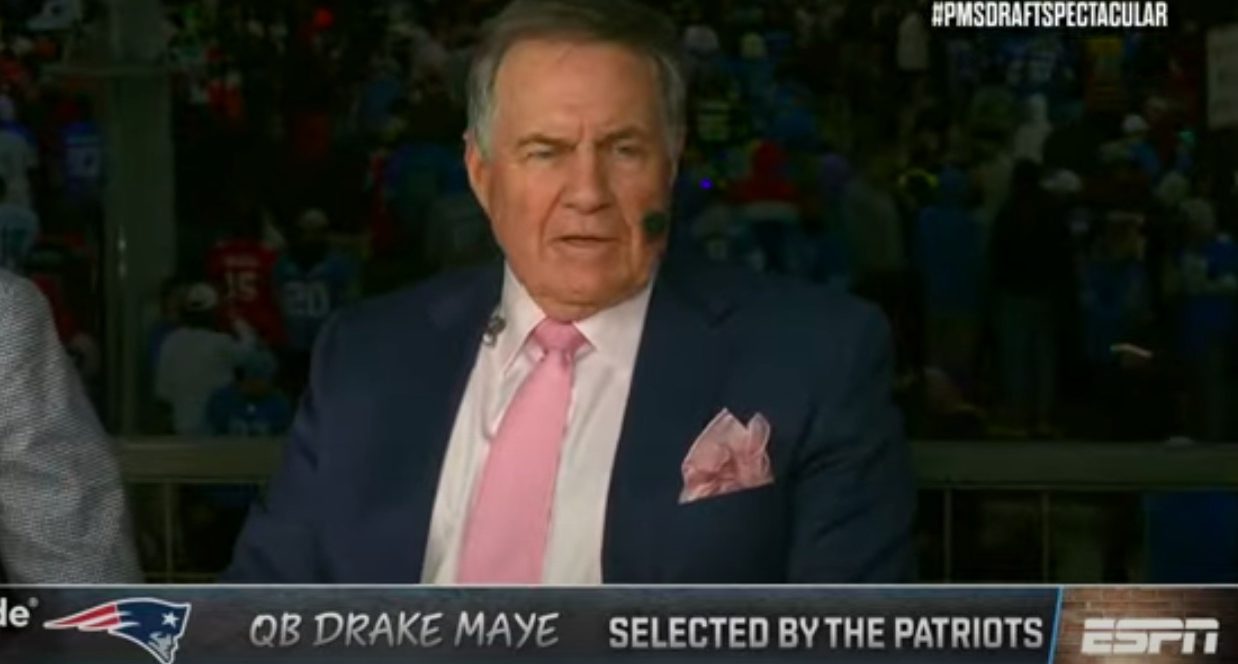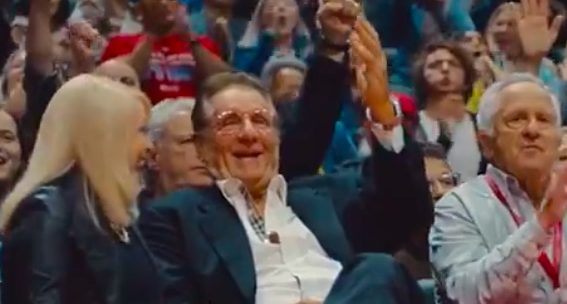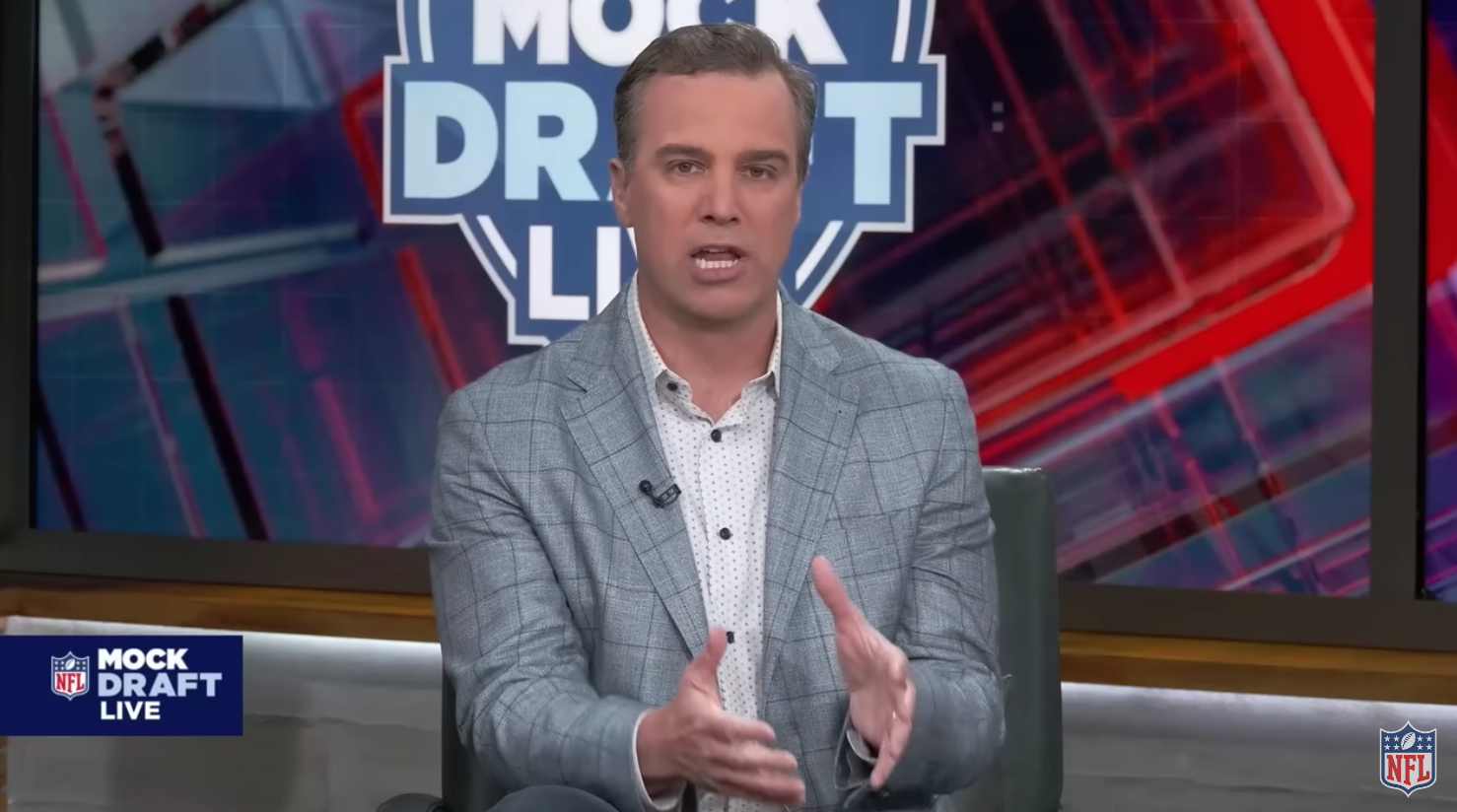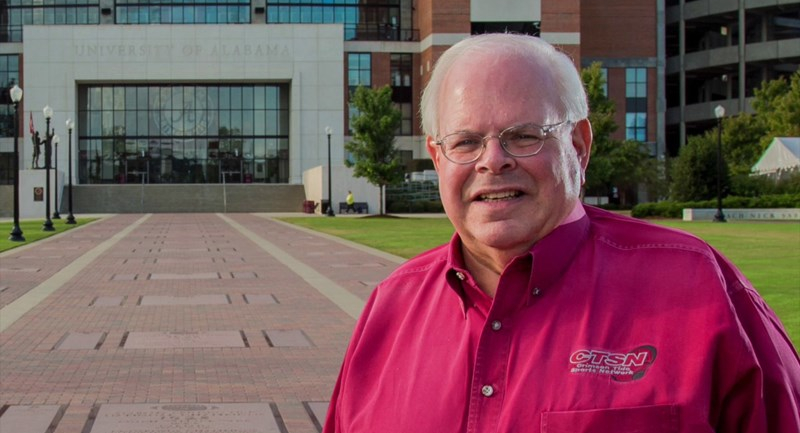PART TWO: What is it like to cover the Masters in person?
What particular stresses do you face while covering the Masters and how do you handle them?
Scott Michaux: For the last 18 years, I’ve covered the Masters for the local newspaper, the Augusta Chronicle. I thought it was going to be really nerve-racking having everybody in the world of golf reading your newspaper that week and that I would be more nervous, but you know, I was more comfortable writing about golf than anything else I’ve ever covered, and I’ve covered every major sport. I just knew what I was talking about with golf, and I just felt comfortable.
I enjoyed the sort of that challenge, being the paper of record for the biggest tournament in golf. We’d do a massive cover story on the defending champion. I’ve been to Australia and Argentina and South Africa chasing down the former Masters champion stories and writing about those. It was a massive undertaking to do it for the local newspaper, but it was it was very rewarding. And it was really fun.
Geoff Shackelford: There’s so much to do in a day and our new media center is well away from the clubhouse and course, so trying to manage time at my desk and also being out and about picking up things or watching play. It’s a good problem to have. But also, just trying to manage different roles for Golfweek and Golf Channel keeps me busy. Players have become tougher to get to talk to during the week over time, probably at their request.
Lorne Rubenstein: All those years I was there, the stresses are often related to if something happens that’s unexpected and you haven’t prepared for it, or something suddenly switches or changes, you have to stop and gather your information. You have to plan ahead. But now, you can jump on something a lot more quickly than you used to be able to do because you can find a lot online. Stresses that I had from starting in 1982 and on into the mid-90s were more along the lines of “I better prepare myself, I better look through the field and see who’s playing.”
Steve DiMeglio: It’s one of the toughest golf tournaments to cover because you can’t get inside the ropes. So you’re battling with the patrons to see the tournament. I’m 5-foot-5, so that doesn’t help me. There are certain places you can’t go, so access isn’t that great. You can’t be on the range. You can’t be inside the ropes on the (practice) putting green. I’ve gotten some great stuff over the years at other tournaments being there. So you really have to pick your spots. We can go in the locker room, but you better make use of your time there. They hate people loitering around in the locker room. Your access is what they tell you your access is.
Doug Ferguson: The only stress, really, is trying to navigate 40,000 people on the grounds as you’re trying to walk.
Jason Sobel: It’s harder, as a journalist, it’s the hardest tournament to cover because you can’t take your phone on the course. I rely on my phone, you know, non-stop these days. I don’t take a notebook with me any other week just because I don’t need it. I record guys and have a recorder on my phone. You can’t do that at the Masters.
Dave Shedloski: There’s always stresses, but you feel like because it’s the Masters you want to put your best foot forward in the coverage you’re providing. But it doesn’t feel like pressure to me, I just want to do a good job.
Melanie Hauser: I think overall, it’s no different than covering anything else. You just have to be sharp in paying a lot of attention. The stakes are higher at the Masters. As with any major, you want to be everywhere at the same time, but you just can’t do it.
Rick Henry: There are the stresses of making deadlines, but that’s something we deal with everyday.
How do you cover a Masters? Do you follow certain golfers around or stay at important holes? How much time do you spend on the course? Do you follow the roars from the crowd?
Hauser: It just depends. You know, you try to go out and get a feel for the different players. The bottom line is, every day and especially on Sundays you have to be there and pretty much be in the press room watching things unfold on the back nine because so many things can happen on so many different holes. For example, in ‘86, we had no idea that Jack was going to do what he was going to do, so a lot of us walked the front nine and then came in and started watching on TV and it was like, “Oh my god.” And, you know, the same things for collapses that happen. You can’t be on the golf course watching somebody when the leader is imploding on 12. So, what you tend to do is maybe walk a little bit early and then come in and watch.
Shackelford: They give you so many options to follow the holes and broadcast from your media center seat that it’s better to just stay inside. I still like to go out and walk the course Sunday to see all the hole locations and get a sense of the course, but otherwise I now watch from inside.
Ferguson: No different from other majors, I’ll start early with a player of significance (Tiger, Spieth, Dustin) and follow for at least nine holes and then readjust if necessary. Sometimes I’ll walk 18 holes in the morning, sometimes 9. I rarely get out in the afternoon because it’s approaching deadline and there’s a need to see what else is going on. Golf is great in this respect: If you’re really paying attention, you can use the roars to figure out what’s going on. I once heard a cheer on the 13th hole (I was on No. 14) and could tell by the nature of the cheer that Fred Couples had hit his second shot to 3 feet.
Rubenstein: Sometimes I’ll follow a few groups over the course of one round and write about how they all handled it. I was lucky to be a columnist because any of that I could write about anything the paper wanted me to, because they would say well that’s why you’re there. You’re not there to write about something necessarily that everybody’s going to be writing about.
Henry: Most years I focus on South Carolina golfers like Dustin Johnson. I’ll also spend time following the leaders.
Michaux: The typical day was getting there early in the morning, spending a lot of time reading the transcripts from the previous day, watching the early action going out on the golf course, following some guys around and standing under the tree outside the clubhouse. Which is the greatest place on earth to conduct interviews because everybody who’s anybody in the golf world is under that tree. Whether they’re playing in the tournament, or played in past tournaments, or part of the media or the governing bodies in golf. There are more interviews to be conducted under that tree than anywhere else and everybody’s in great spirits. It’s really the place to conduct business at that tournament. By the time the leaders go off you follow them around for a little bit and then you’ve got to get in there and start writing.
DiMeglio: I’ll always follow some group for nine holes early in the morning. Because you know there’s going to be spectacular stuff going on all across the course. But I’ll always try to get out there and walk nine holes every day of the tournament. Once you’re there, Sunday is the Drive, Chip and Putt. They started a tradition a few years ago where Masters champions would hand out the trophies to the kids. Some of the green jacket winners will come over and talk to you and you get your story on a Sunday. Faldo did. Sergio has done it. Adam Scott has done it. And then one year, Tiger played on Sunday. We waited him out. He and I have the type of relationship that he’ll stop more times than not. That day, he stopped. The few reporters that were still there, maybe 12 to 15, they all understood that DiMeglio gets to ask the first few questions because Tiger is stopping only because of him.
How many articles do you write each day?
Michaux: I would generally do three a day. One sort of take out piece that I’ve probably been working on for a little while and gathering since before the Masters and trying to unveil those each day. Then, I’ll do what we call an early sidebar on either a local guy, or something else, or a trend that’s happening on the golf course. Then my column is the last thing I do every day. So I generally write three every day for our previous sections that would go in the Sunday paper. Before, I would write probably 20,000 words on the past champion and then I would write about 15 to 18 stories on other players in the field, or trend topics or things like that. So we would fill an 80-page paper preview section.
DiMeglio: Usually at least three. I know there’s a couple days where it’s been five. On Sunday, it’s just a big one. But usually between three and five. I can tell you what Thursday is going to be like. You’ve got to write a Tiger story on Thursday. You have to write Tiger’s round. You have to write it. Hopefully you don’t have to write a weather story. Early leader, the unknown great round shot by somebody. You jump on those.
They’re long days. They’ll put star attractions Thursday morning, and you know the last two or three groups will have stars in it. So if you get Tiger in the morning, you most likely get Jordan Spieth and Phil Mickelson going off at the last tee time. You just go from there. It’s basically like every other tournament. You’ve got to do Tiger and you’ve got to do whatever happens.
Ferguson: I tend to write about four a day from the Masters.
Sobel: We usually are required to write three or four, sometimes even five stories a day for the Masters.
Shackelford: Now it’s more spread out, so we do shorter items and usually one column or bigger story. And of course, lots of tweeting too.
Shedloski: I usually only write one, sometimes more depending on the action from the day. It really just depends.
Rubenstein: Not as many as a beat writer. There were times where I had to scrap a column I had been working on from the morning because something happened in the afternoon that needed attention.
Hauser: I just do a few stories during the week now. I don’t do a lot. When I was working for the internet, we could do two or three easily a day. There’s a lot of demands today. When you’re working for a newspaper it’s less stories. You may just do one or two. If you’re a columnist, you’re probably just going to crank out one column. There’s just so many different options for what you’re doing.
Describe the day in and day out operations of covering the Masters.
Shackelford: I arrive usually around 6:15 am and leave around 8 p.m. every day except maybe Wednesday when we have the Golf Writers dinner at 6:30 pm. The last few years I’ve done appearances on Golf Channel so it gets me there bright and early, and also on occasion through the day on TV.
Ferguson: It’s pretty simple. I’m usually there by 6:30 a.m. to get caught up on reading what’s out there, making plans for the day, contacting the desk in New York. I’ll head out to the course with some of the early starters, carve out 20 minutes for lunch at some point, and file a story from the morning group. We’ll write a few more after it’s over and leave around 9 p.m.
Rubenstein: Normally I’d get there on a Monday, Tuesday at the latest, and I would walk the entire golf course early on. We just want the whole course to ourselves to make some notes or just absorb the atmosphere. I was there as soon as they opened the press room which I think was 8 o’clock or something like that. I loved being there for the whole 12, 13, 14 hours that I would be there. Get there early and leave late.
Are the pimento cheese sandwiches as good as everyone says?
Ferguson: Pimento cheese is good anywhere, but it’s the Masters, so it takes on a life of its own.
Shedloski: There’s too much cheese in the middle. It’s not that I don’t like them, it’s just like there’s one big blob in the middle. It’s a texture thing. It tastes great, but when I eat the pimento cheese sandwiches at the Masters I start around the outside and eat all of the crust and when the crust is all gone, I toss it.
Rubenstein: The pimento cheese sandwich has every chemical known to man. It’s tasty. It’s one of those things you have to go there and have. Personally, I prefer the three ice cream sandwiches over the one-a-day pimento cheese sandwich.
Michaux: We have a full-service restaurant in there now with a waitstaff and hot food and it’s incredible. But I still prefer the old sandwiches that they sell out on the golf course. The egg salad is far and away the best, followed by the Masters club, the pimento cheese is a little bit overrated but it is better than it used to be. It’s become a little spicier than it used to be and I like it more that way. I would only ever think of eating an egg salad sandwich at Augusta National. It’s always the first one thing I grab the first day I get the egg salad and a chocolate milk.
Sobel: I’m not a pimento cheese guy. I don’t like them. I’ll give a couple life hacks here at Augusta. The best thing you can do is go get some bacon and put the bacon on the chicken salad or tuna salad sandwich. It’s awesome, it’s really, really good. So, even if you’re a fan of pimento cheese, put some bacon on there and it gets a lot better.
The prices, though, are what makes it. You can go to Augusta and have a couple beers and a couple sandwiches and pay $8 for the whole thing. It’s so smart and I can’t believe other organizations and other sports haven’t followed this approach. They charge very little for food and don’t make much off food. What happens is people walk out of there saying, “man, I ate and drank all day for $12,” and they go to the merch stand at the end of the day and get nine shirts because they feel like they got a good deal all day.
DiMeglio: There have been stories where someone has tried to spend $40 eating at Augusta National, and they couldn’t do it. The sandwiches are like $2, $2.50. A snickers bar is still 75 cents. The club sandwich is $2.50, maybe $3. They’ve got their own caramel corn that’s the greatest caramel corn in the history of caramel corn. In their new media center, which is basically a $20 million building, they have a buffet for lunch and for breakfast that puts to shame pretty much any other buffet you’ve ever seen. And you can order off the side if you want. They make the greatest hot dog with a grilled toast that you’ve ever had. They have the best fried chicken I’ve ever had.
How has coverage of the Masters changed from when you first started as technology has advanced?
Sobel: Digitally they have done a really good job of providing content through TV and other devices into what today’s digital age can be and should be. That said, they are still very traditional with their own way. Yes, they’re set in their ways, and yes, they’re traditional, but there’s a lot of forward thinking there that people don’t quite understand. There was a time when you could only watch the back nine on TV, people had never seen the front nine of Augusta National unless they went to the tournament. Over the past decade, they’ve been more open and tried to showcase the event better.
Shackelford: The club’s in-house TV system has always been great and that makes following the tournament easy. Players have become tougher to get to talk to during the week over time, probably at their request.
DiMeglio: This was back in the day–maybe 2009 or 2010–and some people have those plug-ins in your computer so you can pick up the wireless and send something. Well, a lot of people didn’t have that back then. Overnight, they hard-wired the entire media center. Overnight. AT&T came in there and hard-wired every single person’s desk. So they get things done. That cliche that “there’s not a blade of grass out of place,” it’s actually true there.
Ferguson: The writing has changed to move it quicker and tighter. We’ll link videos, embed social media if it’s relevant. Video remains an issue because of rights holders (the club or CBS or whomever). The worst technology is TV airing live the press conferences. In some cases, our questions … which produce answers, thus material … is distributed to a viewing audience before we get a chance to use it in stories. Augusta is like no other. We now have computers at every desk that allow a journalist to watch every hole on the back nine, and have tournament statistics at your fingertips. Like anything else, it’s a matter of knowing what to do with that information.
Rubenstein: I remember being in the Quonset hut with the clack of the typewriters, this was before we even had laptops or little Radio Shack computers, and it was crowded. It was kind of fun in that way and you didn’t know any different. It was great to be around there and hear the noise of the typewriters and the keys clanging. People would help one another out. If you couldn’t be in there, and they weren’t writing transcripts, your fellow writer who sat next to you would help you out. These days they might consider that primitive, but I never really saw it that way because it was all that I knew.
Shedloski: A big part of what’s different is social media. Things have just changed a lot since social media came into the picture. Now, something happens and it’s like, “Oh gosh, should I put that on Twitter? How fast can I get that posted?” Immediacy is definitely different now with social media.
Michaux: Well, obviously we spend more time now doing tweeting and giving more live and quick updates than we used to. In 1997 all you did was write stories and I would have to go back to the phones in the top of the old media center and then call them in. Then you know hook up the old couple of lines to them and send it in. It was a lot more complicated than it is now where we’re all on Wi-Fi and you just pop it in your system within seconds right from your desk. So it’s just changed a little bit in terms of filing.
Where do you stay during the tournament? Are accommodations as difficult for you as they are for other people?
Ferguson: We have rented a house from a family for the last 16 years. We rented one house that was just okay, but then stumbled into this one we’re in now and, like most things at Augusta, relationships are formed. I’ve watched the two daughters from that family grow up.
Shedloski: Arrangements aren’t difficult at all for me because all the writers at Golf Digest stay in a house together and it’s arranged by Golf Digest. The houses are very big and can accommodate six or seven of us. There’s never a problem with the housing.
Rubenstein: There is a Masters Housing Bureau, which I think anybody can go to, but obviously there are only so many places. Really, the best thing to do if you’re a member of the media is to get some friends or associates and rent a house together. I would say a high percentage of media stay in homes, and a lot of them stay in the same home every year.
Shackelford: Golfweek rents a house, as do most. Hotels are very pricey.
DiMeglio: I get there Saturday night and get a hotel right across the street. It costs me $80. Later that week, that $80 room turns into over $400. But we get a house that’s about a 15 or 20-minute drive from the golf course for the rest of the week.
PART ONE: First tournaments and the Masters’ popularity.
PART TWO: What is it like to cover the Masters in person?
PART THREE: Favorite players to cover and memorable great moments.
PART FOUR: Collapses and controversies.
PART FIVE: Tiger Woods’ impact on the Masters

